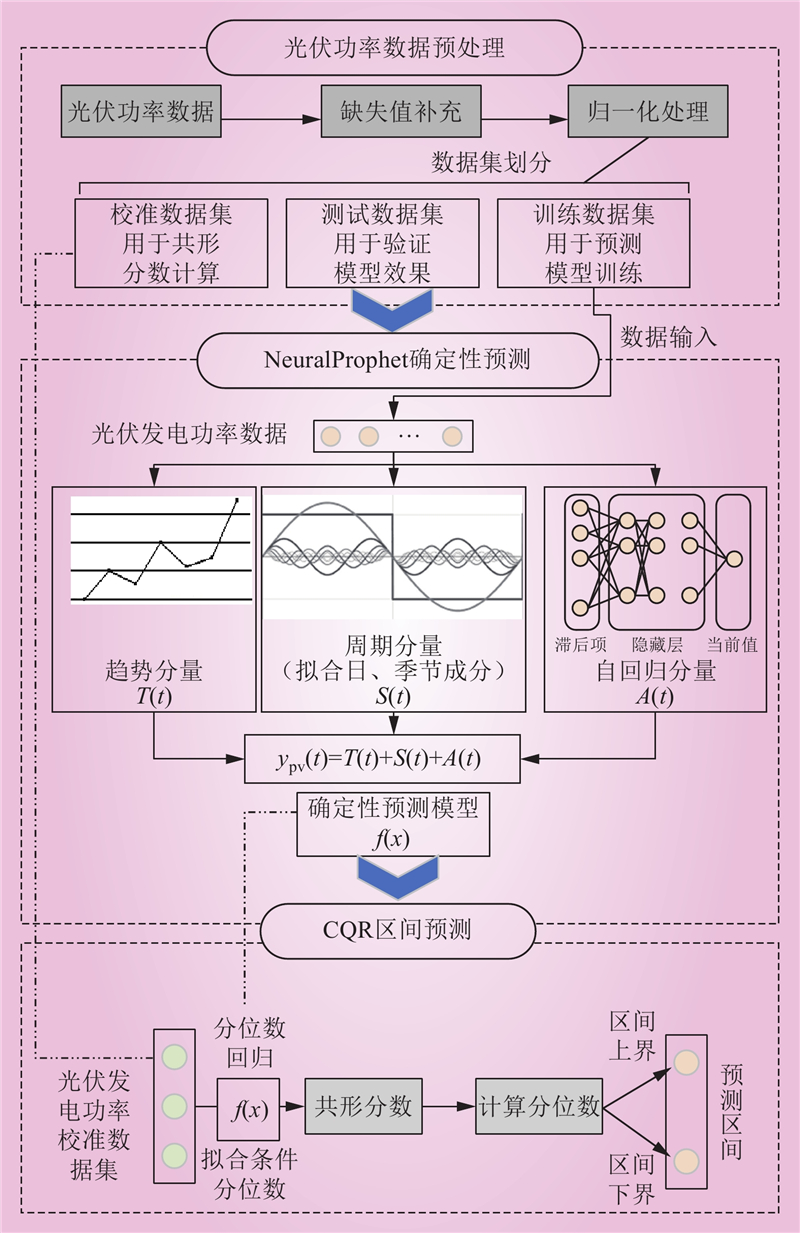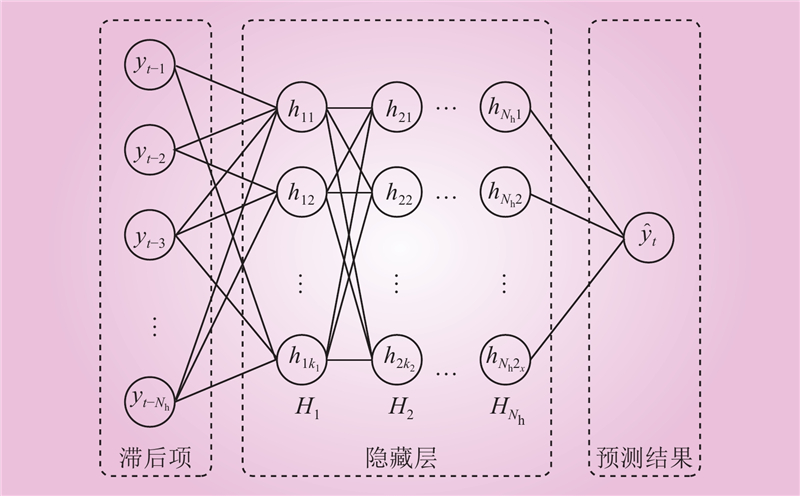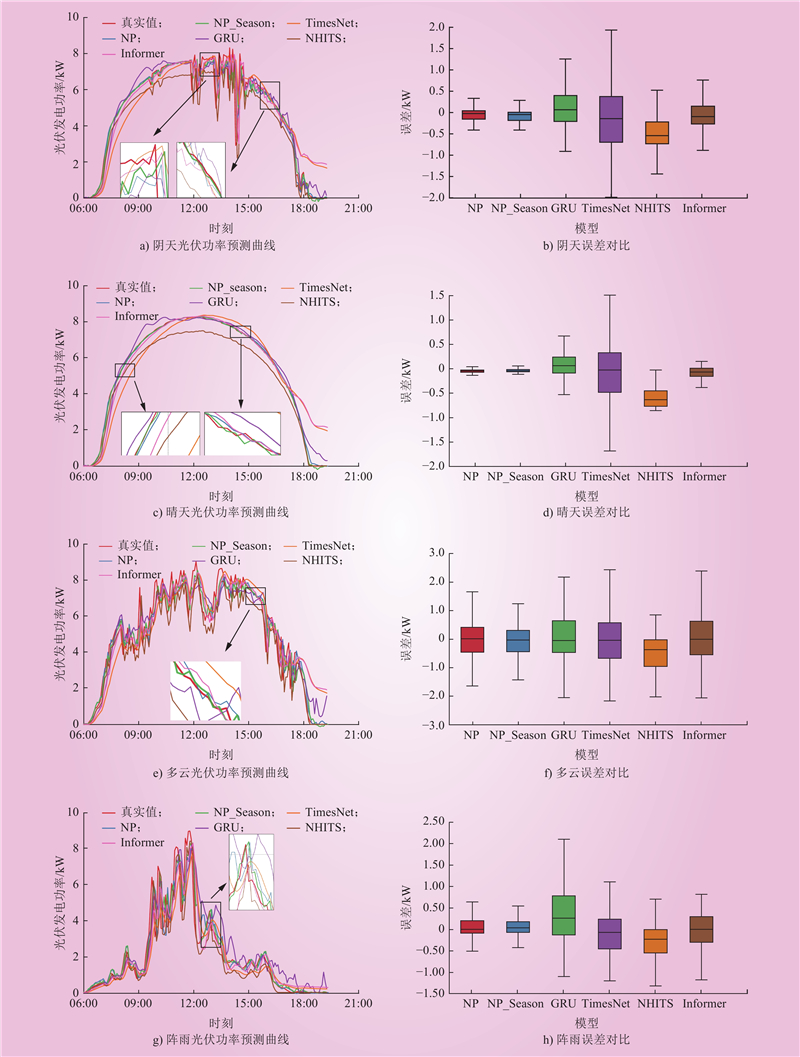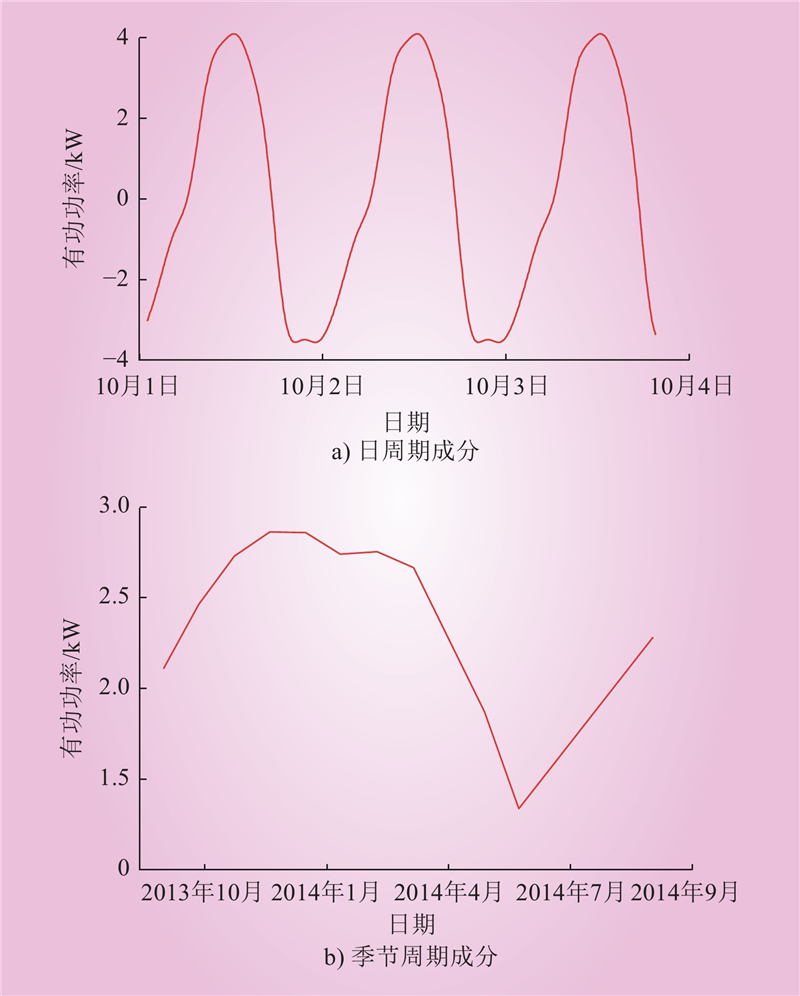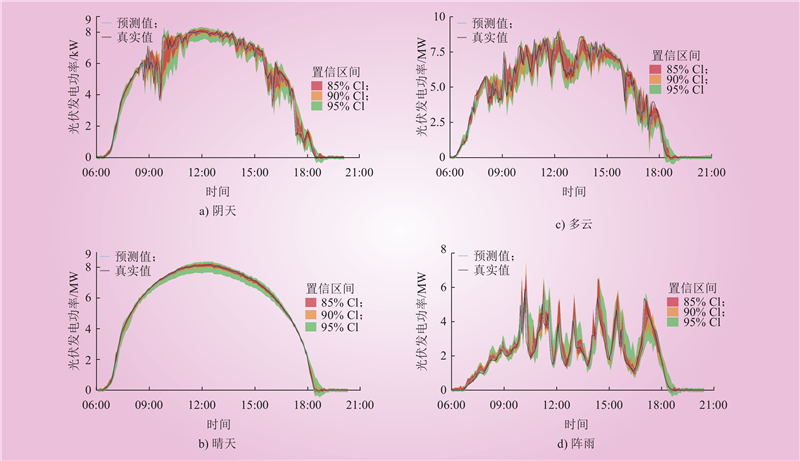| 1 |
原希尧, 王关涛, 朱若源, 等. 碳-绿色证书交易机制下考虑回收P2G余热和需求响应的PIES优化调度[J]. 电力建设, 2023, 44 (3): 25- 35.
|
|
YUAN Xiyao, WANG Guantao, ZHU Ruoyuan, et al. Optimal scheduling of park integrated energy system with P2G waste heat recovery and demand response under carbon-green certificate trading mechanism[J]. Electric Power Construction, 2023, 44 (3): 25- 35.
|
| 2 |
王海军, 居蓉蓉, 董颖华. 基于时空关联特征与B-LSTM模型的分布式光伏功率区间预测[J]. 中国电力, 2024, 57 (7): 74- 80.
|
|
WANG Haijun, JU Rongrong, DONG Yinghua. Distributed photovoltaic power interval prediction based on spatio-temporal correlation feature and B-LSTM model[J]. Electric Power, 2024, 57 (7): 74- 80.
|
| 3 |
王瑞, 高强, 逯静. 基于CEEMDAN-LSSVM-ARIMA模型的短期光伏功率预测[J]. 传感器与微系统, 2022, 41 (5): 118- 122.
|
|
WANG Rui, GAO Qiang, LU Jing. Short-term photovoltaic power prediction based on CEEMDAN-LSSVM-ARIMA model[J]. Transducer and Microsystem Technologies, 2022, 41 (5): 118- 122.
|
| 4 |
PAN M Z, LI C, GAO R, et al. Photovoltaic power forecasting based on a support vector machine with improved ant colony optimization[J]. Journal of Cleaner Production, 2020, 277, 123948.
DOI
|
| 5 |
王伟亮, 刘会巧, 张天宇, 等. 基于多任务集成学习的储能电池剩余使用寿命预测[J]. 电力建设, 2024, 45 (11): 25- 33.
|
|
WANG Weiliang, LIU Huiqiao, ZHANG Tianyu, et al. Multi-task ensemble learning-based prediction of remaining useful life of energy-storage batteries[J]. Electric Power Construction, 2024, 45 (11): 25- 33.
|
| 6 |
王开艳, 杜浩东, 贾嵘, 等. 基于相似日聚类和QR-CNN-BiLSTM模型的光伏功率短期区间概率预测[J]. 高电压技术, 2022, 48 (11): 4372- 4388.
|
|
WANG Kaiyan, DU Haodong, JIA Rong, et al. Short-term interval probability prediction of photovoltaic power based on similar daily clustering and QR-CNN-BiLSTM model[J]. High Voltage Engineering, 2022, 48 (11): 4372- 4388.
|
| 7 |
滕陈源, 丁逸超, 张有兵, 等. 基于VMD-Informer-BiLSTM模型的超短期光伏功率预测[J]. 高电压技术, 2023, 49 (7): 2961- 2971.
|
|
TENG Chenyuan, DING Yichao, ZHANG Youbing, et al. Ultra-short-term photovoltaic power prediction based on VMD-informer-BiLSTM model[J]. High Voltage Engineering, 2023, 49 (7): 2961- 2971.
|
| 8 |
张冬冬, 单琳珂, 刘天皓. 人工智能技术在风力与光伏发电数据挖掘及功率预测中的应用综述[J]. 综合智慧能源, 2025, 47 (3): 32- 46.
|
|
ZHANG Dongdong, SHAN Linke, LIU Tianhao. Review on the application of artificial intelligence in data mining and wind and photovoltaic power forecasting[J]. Integrated Intelligent Energy, 2025, 47 (3): 32- 46.
|
| 9 |
任密蜂, 王家辉, 叶泽甫, 等. 一种适用于单/多光伏电站的迁移超短期光伏预测建模框架[J]. 太阳能学报, 2024, 45 (6): 359- 367.
|
|
REN Mifeng, WANG Jiahui, YE Zefu, et al. Transfer ultra-short term photovoltaic prediction modeling framework for single/multiple photovoltaic power stations[J]. Acta Energiae Solaris Sinica, 2024, 45 (6): 359- 367.
|
| 10 |
林帆, 张耀, 东琦, 等. 基于分位数插值和深度自回归网络的光伏出力概率预测[J]. 电力系统自动化, 2023, 47 (9): 79- 87.
DOI
|
|
LIN Fan, ZHANG Yao, DONG Qi, et al. Probability prediction of photovoltaic output based on quantile interpolation and deep autoregressive network[J]. Automation of Electric Power Systems, 2023, 47 (9): 79- 87.
DOI
|
| 11 |
张娜, 葛磊蛟. 基于SOA优化的光伏短期出力区间组合预测[J]. 太阳能学报, 2021, 42 (5): 252- 259.
|
|
ZHANG Na, GE Leijiao. Photovoltaic system short-term power interval hybrid forecasting method based on seeker optimization algorithm[J]. Acta Energiae Solaris Sinica, 2021, 42 (5): 252- 259.
|
| 12 |
梅飞, 顾佳琪, 裴鑫, 等. 基于自适应滚动匹配预测修正模式的光伏区间预测[J]. 电力自动化设备, 2022, 42 (2): 92- 98.
|
|
MEI Fei, GU Jiaqi, PEI Xin, et al. Photovoltaic interval prediction based on adaptive rolling matching prediction correction mode[J]. Electric Power Automation Equipment, 2022, 42 (2): 92- 98.
|
| 13 |
YU M, NIU D X, WANG K K, et al. Short-term photovoltaic power point-interval forecasting based on double-layer decomposition and WOA-BiLSTM-Attention and considering weather classification[J]. Energy, 2023, 275, 127348.
DOI
|
| 14 |
杨国清, 李建基, 王德意, 等. 基于信息熵变权区间组合和边界逼近的短期光伏功率区间预测[J]. 太阳能学报, 2023, 44 (2): 381- 390.
|
|
YANG Guoqing, LI Jianji, WANG Deyi, et al. Short-term photovoltaic power interval prediction based on information entropy variable weight interval combination and boundary approximation[J]. Acta Energiae Solaris Sinica, 2023, 44 (2): 381- 390.
|
| 15 |
吴振威, 蒋小平, 马会萌, 等. 多时间尺度的光伏出力波动特性研究[J]. 现代电力, 2014, 31 (1): 58- 61.
DOI
|
|
WU Zhenwei, JIANG Xiaoping, MA Huimeng, et al. Study on fluctuations characteristics of photovoltaic power output in different time scales[J]. Modern Electric Power, 2014, 31 (1): 58- 61.
DOI
|
| 16 |
张东宁. 基于改进电导增量法的光伏最大功率点跟踪策略研究[J]. 太阳能学报, 2022, 43 (8): 82- 90.
|
|
ZHANG Dongning. Research on photovoltaic maximum power point tracking strategy based on improved conductance increment method[J]. Acta Energiae Solaris Sinica, 2022, 43 (8): 82- 90.
|
| 17 |
KOENKER R, HALLOCK K F. Quantile regression[J]. Journal of Economic Perspectives, 2001, 15 (4): 143- 156.
DOI
|
| 18 |
BARBER R F, CANDÈS E J, RAMDAS A, et al. Conformal prediction beyond exchangeability[J]. The Annals of Statistics, 2023, 51 (2): 816- 845.
|
| 19 |
OLSSON H, KARTASALO K, MULLIQI N, et al. Estimating diagnostic uncertainty in artificial intelligence assisted pathology using conformal prediction[J]. Nature Communications, 2022, 13 (1): 7761.
DOI
|
| 20 |
HU J M, LUO Q X, TANG J W, et al. Conformalized temporal convolutional quantile regression networks for wind power interval forecasting[J]. Energy, 2022, 248, 123497.
DOI
|
| 21 |
KATH C, ZIEL F. Conformal prediction interval estimation and applications to day-ahead and intraday power markets[J]. International Journal of Forecasting, 2021, 37 (2): 777- 799.
DOI
|
| 22 |
苏子越, 柴琳, 谢亮, 等. 基于变分模态分解的综合能源系统短期电负荷预测[J]. 热力发电, 2024, 53 (12): 21- 28.
|
|
SU Ziyue, CHAI Lin, XIE Liang, et al. Short-term electrical load forecasting for integrated energy system based on variational mode decomposition[J]. Thermal Power Generation, 2024, 53 (12): 21- 28.
|
| 23 |
TRIEBE O, HEWAMALAGE H, PILYUGINA P, et al. NeuralProphet: explainable forecasting at scale[EB/OL]. (2021-11-29) [2024-5-12]. https://arxiv.org/abs/2111.15397v1.
|
| 24 |
俞胜, 黄福兴, 冯艳丽, 等. 新型电力AMI系统中基于Neural Prophet模型的电力负荷预测与修补研究[J]. 智慧电力, 2023, 51 (5): 44- 50.
DOI
|
|
YU Sheng, HUANG Fuxing, FENG Yanli, et al. Neural prophet-based power load forecasting and repair in novel power AMI system[J]. Smart Power, 2023, 51 (5): 44- 50.
DOI
|
| 25 |
TRIEBE O, LAPTEV N, RAJAGOPAL R. AR-Net: a simple auto-regressive neural network for time-series[EB/OL]. (2019-11-27) [2024-6-29]. https://arxiv.org/abs/1911.12436v1.
|
| 26 |
FONTANA M, ZENI G, VANTINI S. Conformal prediction: a unified review of theory and new challenges[J]. Bernoulli, 2023, 29 (1): 1- 23.
|
| 27 |
雷雯雯. 草图算法在共形预测中的应用[D]. 桂林: 桂林电子科技大学, 2023.
|
|
LEI Wenwen. Application of sketching algorithm in conformal prediction[D]. Guilin: Guilin University of Electronic Technology, 2023.
|
| 28 |
Desert Knowledge Australia Centre. Download Data. Alice Springs[EB/OL]. (2023-10-6) [2024-05-13]. http://dkasolarcentre.com.au/download.
|
| 29 |
侯健敏, 孟莹, 李志, 等. 基于综合相关性指标与SA-BiGRU的综合能源系统多元负荷预测[J]. 电力建设, 2024, 45 (5): 118- 130.
|
|
HOU Jianmin, MENG Ying, LI Zhi, et al. Multi-energy load forecasting in integrated energy systems based on comprehensive correlation index and SA-BiGRU network[J]. Electric Power Construction, 2024, 45 (5): 118- 130.
|
| 30 |
WU H X, HU T G, LIU Y, et al. TimesNet: temporal 2D-variation modeling for general time series analysis[EB/OL]. (2022-10-5) [2024-8-6]. https://arxiv.org/abs/2210.02186v3.
|
| 31 |
CHALLU C, OLIVARES K G, ORESHKIN B N, et al. NHITS: neural hierarchical interpolation for time series forecasting[J]. Proceedings of the AAAI Conference on Artificial Intelligence, 2023, 37 (6): 6989- 6997.
DOI
|
| 32 |
ZHOU H Y, ZHANG S H, PENG J Q, et al. Informer: beyond efficient transformer for long sequence time-series forecasting[J]. Proceedings of the AAAI Conference on Artificial Intelligence, 2021, 35 (12): 11106- 11115.
DOI
|


